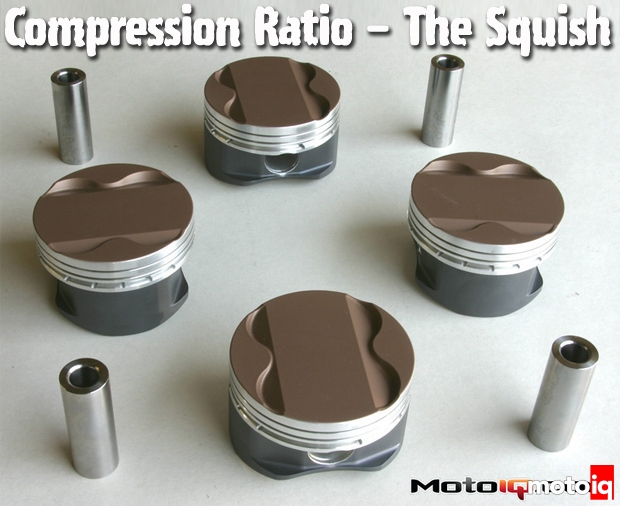,
Going back to our simple Otto cycle, we can calculate a thermal efficiency of the cycle based on compression ratio. Using what is called the Air Standard Otto Cycle (assumes a constant specific heat value for air), we get a really simple equation where all you need to know is the compression ratio and the ratio of constant specific heats of air (k=1.4). As you can see in the plot, increasing the compression ratio increases the thermal efficiency of the cycle.
 |
| Higher compression ratio leads to higher efficiency. |
So what does increasing the compression ratio look like on the P-V and T-S diagrams? Increasing the thermal efficiency of the cycle means getting more work out of the heat (fuel) put into the cycle. As a quick reminder, Work = Force (N) X Distance (m), Pressure = Force (N)/Area (m^2), and Volume (m^3) = Area (m^2) X Distance (m). So Pressure (N/m^2) X Volume (m^3) = Force (N) X Distance (m) = Work (N*m). Work is also known as Torque or Energy. Pretty cool how math works out huh? So why the P*V = Work calculation? Now we can look at our P-V chart and take the area under the curves to represent the amount of work done in the cycle.
 |
| These P-V and T-S diagrams show two Otto cycles with different compression ratios. The lower compression ratio cycle is represented by 1,2,3,4. The work into the cycle (compression) is taken by the area A,B,2,1. The work out of the cycle is A,B,3,4. The net work out of the cycle is the difference between the two areas, 1,2,3,4. The higher compression ratio cycle is represented by 1,2’,3’,4. As you can see, the area under 1,2′,3′,4 is greater than 1,2,3,4 even though the heat input (2,3 and 2′,3′) are the same. With the higher compression ratio, you get more work out of the same heat input which means greater thermal efficiency. Disclaimer: I made these diagrams using my mad Power Point skillz. |
So a higher compression ratio means getting more work out of the same fuel. Why don’t we just run a super high compression ratio? Looking back at the T-S diagram, you can see that a higher compression ratio also means a higher pressure and temperature in the cylinder. This of course goes back to the ideal gas law. The higher pressure and temperature leads to pre-ignition and detonation which is really good at breaking engine parts.
The compression ratio for forced induction (turbo or supercharged) engines must be lower due to this phenomenon. Forced induction engines make power by burning more fuel. To burn more fuel, you need more air. To fit more air in the cylinder, you have to compress it to a greater density which requires forced induction. More fuel really increases the pressure and temperature of combustion. A higher compression ratio would of course lead to pre-ignition and detonation.
 |
| These charts compare a naturally aspirated engine to a forced induction engine. The fuel addition for the FI engine 2′,3′ is about double that of the NA engine 2,3 in this case. This results in a lot more work (area under the curve) and also a lot higher temperature. If the compression ratio for the FI engine were the same as the NA engine, then the pressure and temperature would be even higher resulting in knock. |
Using the good ole P-V and T-S diagrams for the Otto Cycle, you can see that a higher compression ratio gets you more work out of the same amount of fuel. Higher is better up to the knock limit of the fuel you’re using. Forced induction cars need a lower compression ratio to avoid knock due to the really high cylinder pressure and temperatures caused by the greater amount of fuel burned. Thermo is cool, stay in school.



